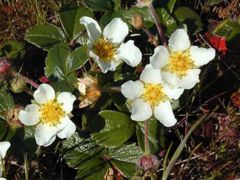Fragaria chiloensis
| Fragaria chiloensis subsp. var. | Beach strawberry | |||||||||||||||||||||||||||||||||||||||||||||||||||||||
|---|---|---|---|---|---|---|---|---|---|---|---|---|---|---|---|---|---|---|---|---|---|---|---|---|---|---|---|---|---|---|---|---|---|---|---|---|---|---|---|---|---|---|---|---|---|---|---|---|---|---|---|---|---|---|---|---|

|
|
| ||||||||||||||||||||||||||||||||||||||||||||||||||||||
| ||||||||||||||||||||||||||||||||||||||||||||||||||||||||
The beach strawberry, Chilean strawberry, or coastal strawberry (Fragaria chiloensis) is one of two species of strawberry that were hybridized to create the modern garden strawberry (F. × ananassa). It is noted for its large berries. Its natural range is the Pacific Ocean coasts of North and South America, and also [[Hawaii|HawaiTemplate:Okinai]]. Migratory birds are thought to have dispersed F. chiloensis from the Pacific coast of North America to the mountains of HawaiTemplate:Okinai, Chile, and Argentina.[1]
It is an evergreen plant growing to 15 - 30 cm tall, with glossy green trifoliate leaves, each leaflet around 5 cm in long. The flowers are white, produced in spring and early summer. The fruit is edible, red on the surface, white inside.
Its fruit is still sold as a local delicacy in some South American produce markets.
| Standard Cyclopedia of Horticulture |
|---|
|
Fragaria chiloensis, Duchesne. Low, but stout in all its parts: lvs. thick, more or less glossy above, bluish white below, blunt-toothed: fl.-clusters forking and long-rayed, the peduncle short, soon lopping on the ground: runners mostly appearing after the fr. is gone: berry large and firm, dark-colored, more or less musky in flavor, reinforced by a very large calyx or hull. Pacific coast region Peru to Patagonia. —A common wild strawberry of the Pacific slope from Alaska to Calif., is considered to be the same species. CH
|
Cultivation
- Do you have cultivation info on this plant? Edit this section!
Propagation
- Do you have propagation info on this plant? Edit this section!
Pests and diseases
- Do you have pest and disease info on this plant? Edit this section!
Varieties
There are a number of subspecies and forms:
- Fragaria chiloensis subsp. chiloensis forma chiloensis
- Fragaria chiloensis subsp. chiloensis forma patagonica (Argentina, Chile)
- Fragaria chiloensis subsp. lucida (E. Vilm. ex Gay) Staudt (coast of British Columbia, Washington, Oregon, California)
- Fragaria chiloensis subsp. pacifica Staudt (coast of Alaska, British Columbia, Washington, Oregon, California)
- Fragaria chiloensis subsp. sandwicensis (Decne.) Staudt - Template:OkinaŌhelo papa ([[Hawaii|HawaiTemplate:Okinai]])
Gallery
If you have a photo of this plant, please upload it! Plus, there may be other photos available for you to add.
-
Fragria chiloensis subsp. chiloensis forma chiloensis
-
photo 2
-
photo 3
References
- Standard Cyclopedia of Horticulture, by L. H. Bailey, MacMillan Co., 1963
External links
- w:Fragaria chiloensis. Some of the material on this page may be from Wikipedia, under the Creative Commons license.
- Fragaria chiloensis QR Code (Size 50, 100, 200, 500)
- ↑ Sauer, Jonathan D. (1993). Historical Geography of Crop Plants: A Select Roster. CRC Press. pp. 128–129. ISBN 0849389011.

